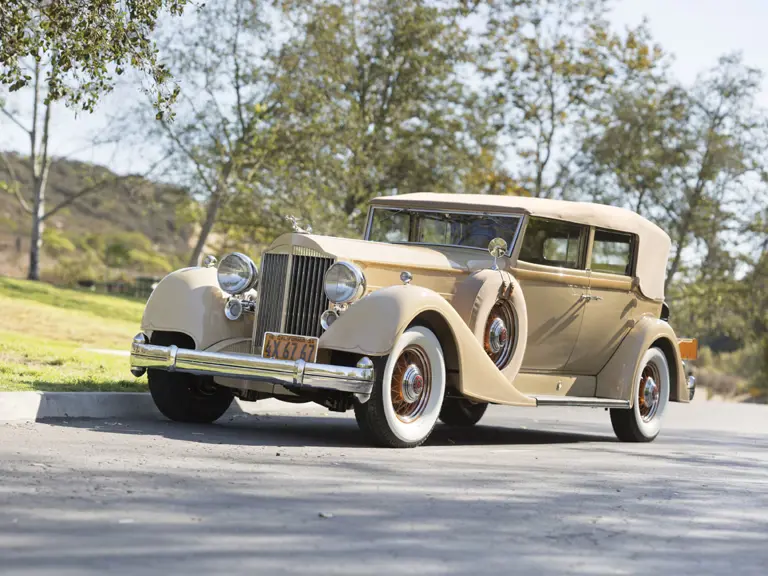Engine no. 902424
This handsome Model 1107 Packard Twelve Convertible Sedan is one of a mere 29 produced and is one of 10 known survivors. It features a superb older restoration and is powered by the respected 445-cid, 160-hp side-valve V-12 engine with a Stromberg downdraft carburetor. A three-speed synchromesh manual transmission and automatic cold start are also part of this splendid package that is built on a 142-inch chassis.
This and the 11th series were the last cars with flowing fenders and traditional classic lines before the advent of the streamlined look. The front ensemble is truly beautiful, with a graceful vee-shaped radiator and matching headlights and fender lights. The dash is a work of art, looking more like a jeweler’s display case than an instrument panel.
Convertible sedans were both expensive and popular, as they combined the security and comfort of a closed car with the ability to fully lower the top and windows and enjoy a true open car. Convertible sedans were also the only open style suitable for formal use when fitted (as in this case) with a fully retractable division window. The result was a chauffeur-driven formal car with a division window when the top was up and a sporty owner-driven open car when it was lowered.
This beautiful convertible sedan is finished with an attractive cream-colored body accented by a beige belt molding; the exterior of the car is further accented by the use of orange wheels and a matching pinstripe. The interior of the car is equally impressive, with dark tan leather throughout and accented with luxurious wood trimmings. Cosmetically, the car presents very nicely. Well equipped, this impressive Packard is fitted with desirable period options, including dual sidemounts and an original, unrestored rear-mounted trunk. The seven-day wind-up clock keeps perfect time, and the radio, a very rare option, is fully functional and complete with its own key.
The example offered here has benefited from a thorough and correct restoration in the early-1980s for Robert Milhous by Bob Smith. Soon thereafter it won Best in Class at Pebble Beach in 1985. It was later acquired by Mr. O’Quinn in 2007, where it remained in climate-controlled storage. Since being acquired by the current vendor, this fantastic Packard has gone on to win a number of additional awards, attesting to the quality of the restoration and its current condition. It is correct in virtually all respects, even retaining its original brass Dietrich body tag, which was affixed to all of the standard bodies of the time; it is stamped with the number “743,” reflecting the convertible sedan body style, as well as “6563,” which is the Dietrich-assigned body number. The 1934 Packard Twelves are considered to be the most desirable of the Classic Era vehicles, due to their extraordinary driving characteristics and great design attributes. The lines on this particular motor car are without fault, and its condition permits it to be shown or driven with pride.
Packard’s Twelve was, in many ways, the signature car of the Classic Era; it was the top-of-the-line offering from America’s leading manufacturer of fine cars. A conservative car with finely tailored lines, it had elegant appointments, a refined chassis, and a whisper-quiet, 12-cylinder engine.
In a sense, Packard’s Twelve was never meant to be. In fact, the car’s history goes back to the Cord L-29 and the great Miller-engined front-wheel drive racecars. Packard’s management was intrigued with the idea of front-wheel drive and commissioned the construction of a prototype. A decision was made to develop a 12-cylinder engine for this new car, as the shorter length of a V-12, compared with Packard’s venerable inline eight, allowed more flexibility in packaging the front-drive chassis.
Extensive testing revealed weaknesses in the front-drive chassis’ design, and anticipated development costs soared. Meanwhile, Cadillac had ignited the multi-cylinder race with their exquisite new 16- and 12-cylinder models, and Packard’s dealerships were feeling the pressure. The solution, born of necessity, was to install the new 12-cylinder engine in Packard’s proven Deluxe Eight chassis. This created one of the defining models of the Classic Era: the Twin Six, in honor of Packard’s first V-12, which was introduced more than 15 years earlier. By 1933, the name had been changed to the Packard Twelve to more clearly convey the power behind the new car.



 | Fort Lauderdale, Florida
| Fort Lauderdale, Florida


